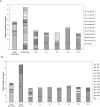Persistence and differential survival of fecal indicator bacteria in subtropical waters and sediments
- PMID: 15933000
- PMCID: PMC1151827
- DOI: 10.1128/AEM.71.6.3041-3048.2005
Persistence and differential survival of fecal indicator bacteria in subtropical waters and sediments
Abstract
Fecal coliforms and enterococci are indicator organisms used worldwide to monitor water quality. These bacteria are used in microbial source tracking (MST) studies, which attempt to assess the contribution of various host species to fecal pollution in water. Ideally, all strains of a given indicator organism (IO) would experience equal persistence (maintenance of culturable populations) in water; however, some strains may have comparatively extended persistence outside the host, while others may persist very poorly in environmental waters. Assessment of the relative contribution of host species to fecal pollution would be confounded by differential persistence of strains. Here, freshwater and saltwater mesocosms, including sediments, were inoculated with dog feces, sewage, or contaminated soil and were incubated under conditions that included natural stressors such as microbial predators, radiation, and temperature fluctuations. Persistence of IOs was measured by decay rates (change in culturable counts over time). Decay rates were influenced by IO, inoculum, water type, sediment versus water column location, and Escherichia coli strain. Fecal coliform decay rates were significantly lower than those of enterococci in freshwater but were not significantly different in saltwater. IO persistence according to mesocosm treatment followed the trend: contaminated soil > wastewater > dog feces. E. coli ribotyping demonstrated that certain strains were more persistent than others in freshwater mesocosms, and the distribution of ribotypes sampled from mesocosm waters was dissimilar from the distribution in fecal material. These results have implications for the accuracy of MST methods, modeling of microbial populations in water, and efficacy of regulatory standards for protection of water quality.
Figures



References
-
- American Public Health Association. 1995. Standard methods for the examination of water and wastewater, 19th ed. American Public Health Association, Inc., Washington, D.C.
-
- Byappanahalli, M., D. A. Shively, M. B. Nevers, M. J. Sadowsky, and R. L. Whitman. 2003. Growth and survival of Escherichia coli and enterococci populations in the macro-alga Cladophora (Chlorophyta). FEMS Microbiol. Ecol. 46:203-211. - PubMed
-
- Byappanahalli, M. N., and R. S. Fujioka. 1998. Evidence that tropical soil can support the growth of Escherichia coli. Water Sci. Technol. 38:171-174.
Publication types
MeSH terms
Substances
LinkOut - more resources
Full Text Sources
Medical
Molecular Biology Databases

